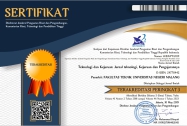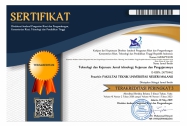Implementation of Work-Based Learning at Teaching Factory in Vocational Education
Abstract
Vocational education aims to prepare graduates to be work-ready. Vocational education institutions, as preparer and providers of skilled labor candidate, must be able to utilize their resources and network partnerships resources with outsiders effectively. One way to meet the objectives of vocational education is to apply work-based learning in teaching factories. Work-based learning is a Contextual teaching-learning (CTL) approach where the business world or industrial world provides a set of structured work-based learning experiences. While teaching factory is the development of the production unit, namely the implementation of industrial partnership systems in the existing production units at SMK. The implementation of work-based learning in teaching factories in vocational education is expected to be able to increase the competitiveness of graduates.
Keywords
Full Text:
PDFReferences
Direktorat PSMK. (2017). Panduan Teknis Teaching Factory. Jakarta: Direktorat PSMK
Indriaturrahmi & Sudiyatno. (2016). Peran Dunia Usaha dan Dunia Industri dalam Penyelenggaraan SMK Berbasis Kearifan Lokal di Kota Mataram. Jurnal Pendidikan Vokasi, 6(2): 162-172.
Instruksi Presiden Nomor 9 Tahun 2016 tentang Revitalisasi SMK.
Kemendikbud. (2017). 10 Langkah Revitalisasi SMK Revisi. Jakarta: Kemendikbud.
Komaruddin, et. al. (2018). Contribution of Teaching Factory, Basic Knowledge, And Self Efficacy to Vocational Competence and it’s Impact to Work Readiness. International Journal of Novel Research in Education and Learning, 5(1), 1-7.
Kuswantoro, A. (2014). Teaching Factory. Yogyakarta: Graha Ilmu.
Little, B. et al. (2006). Employability and Work-Based Learning. London: HEA.
Muliati, A. (2008). Evaluasi Program Pendidikan Sistem Ganda (PSG) (Suatu Penelitian Evaluatif Berdasarkan Stake’s Countenance Model Mengenai Program Pendidikan Sistem Ganda pada Sebuah SMK di Sulawesi Selatan). Disertasi tidak diterbitkan. Jakarta: PPs UNJ.
Paidi. (2013). Teaching Factory Sebagai Pendekatan Belajar di SMK. Admin Diknas Kota.
Paris, K.A., & Mason, S.A. (1995). Planning and implementing youth apprenticeship and work-based learning. Wisconsin: Center on Education and Work, University of Wisconsin.
Pavlova, M. (2009). Technology and Vocational Education for Sustainable Development: Empowering Individuals for the Future (Volume 10) (R. Maclean, Ed). New York: Springer.
Peraturan Pemerintah No. 41/2015, tentang: Peraturan Presiden (PERPRES) tentang Kementerian Badan Usaha Milik Negara
Undang-Undang Republik Indonesia No. 20 tahun 2003 Tentang Sistim Pendidikan Nasional. 2003. Jakarta: Departemen Pendidikan Nasional Republik Indonesia
Wagiran, (2010). Pengembangan Pendidikan Kejuruan Berbasis Potensi Daerah dan Sumber Daya Alam Dalam Mendukung Continuing Vocational Education. Yogyakarta: Universitas Negeri Yogyakarta.
Yoto. (2016). Vocational education development strategy to improve quality of human resources in dealing with Asean Economic Community. AIP Conference Proceedings 1778.
Zazin, N. (2011). Gerakan menata Mutu Pendidikan, Teori dan Aplikasi. Jakarta: Ar- Ruzz Media.
DOI: http://dx.doi.org/10.17977/um031v43i22020p150-155
Refbacks
- There are currently no refbacks.
Copyright (c) 2020 Teknologi dan Kejuruan: Jurnal Teknologi, Kejuruan, dan Pengajarannya
Teknologi dan Kejuruan: Jurnal Teknologi, Kejuruan, dan Pengajarannya
E-ISSN 2477-0442 (online)
Contact
Faculty of Engineering, Universitas Negeri Malang (UM)
Jl. Semarang No 5 Malang 65145, Building H5, 1st Floor.
Homepage: http://journal2.um.ac.id/index.php/teknologi-kejuruan
Email: teknologikejuruan.ft@um.ac.id

This work is licensed under a Creative Commons Attribution 4.0 International License.



2.png)
1.png)
1.png)
1.png)
4.png)
1.png)
.png)

3.png)
1.png)
1.png)


